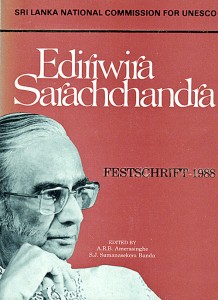Birth centenary of a unique personality
View(s):June 3 marked the birth centenary of Professor Ediriweera Sarachchandra. In the University College days he was Professor of Pali after he was awarded a doctorate by the University of London in 1949 where he did a post graduate degree on Western Philosophy. His research study was on ‘The Buddhist Psychology of Perception and the Theory of Bhavanga’. However, in 1952, he started teaching modern Sinhalese literature and we were fortunate enough to follow his lectures when we went up to Peradeniya as freshers in 1953. Two years later he was awarded a Rockefeller Foundation grant to study drama. It was after he returned that he produced ‘Maname’– the landmark drama in modern Sinhala theatre.
I remember negotiating with him in the late 1960s to serialise an English translation of ‘Malawunge avurudu da’ (published in 1965) in the Sunday Observer when I was its features editor. Edwin Ariyadasa who was then at Lake House did the translation.
Apart from Dr. Sarachchandra’s novels and other writings, in my little library is the Sarachchandra Felicitation Volume done by the Sri Lanka National Commission for UNESCO. A most fitting tribute to the multi-faceted artist.For some reason it was not freely available at bookstalls and it was with difficulty that I got a copy. The UNESCO Commission had moved from the Education Ministry to the Justice Ministry and no one knew where its office was. In fact, when I took the book to Dr. Sarachchandra to get it autographed in 1990 (August 21 to be exact – he was chief guest at the opening of the Wijesoma cartoon exhibition at Sri Jayawardenapura University), he told me it was the first time he was seeing it.
The publication edited by Dr. A.R.B. Amararasinghe, one time Secretary – Ministry of Justice and S.J. Sumanasekera Banda, Additional Secretary – Ministry of Justice & Additional Secretary General – UNESCO Commission, contains a dozen articles by academics and dramatists. In his introduction Professor Ashley Halpe quotes from the play, ‘Pemato Jayati Soko’ to illustrate Dr. Sarachchandra’s “sense of responsibility, of vocation, evident in every phase and aspect of his work – whether as artist, critic, teacher or public man.” He ends by stating that the volume “seeks to suggest the range and depth of the achievements of this many sided man, an achievement that has helped to shape much that is best in modern Lankan culture”.
Prof. Yasmine Gooneratne examines Dr. Sarachchandra as an Asian writer, and Bandhula Jayawardhana discusses his place in contemporary Sinhala theatre. ‘The Problem of Language in the Sinhala Theatre’ (Dr. Ranjini Obeysekera), ‘The Poetic Dramas – Text and Technique’ (Dr. Lakshmi de Silva), and ‘The Novels 1978-1987’ (Dr. Ashley Halpe) are among the other articles that delve into different aspects of Dr. Sarachchandra’s creativity.
Six reproductions of sketches by Krl-Erich Muller, a painter from Halle (then GDR), during a performance of ‘Maname’ in 1977 add value to the publication. He had done 12 drawings all in crayon on the spot on special paper and later imprinted on stone for reproduction. In an accompanying note, Professor Dr Heinz Mode – “a study mate (of Dr. Sarachchandra) in oriental studies at the Colombo College 1932/33 and ever since good friend” –gives his impressions of ‘Maname’: “It cannot be denied that ‘Maname’ has opened a new vista for the theatre of Sri Lanka and has been and still is a link to classical Buddhist inspired subject-matter and contemporary literary, musical and dance – creational spirit, written, composed and put on stage again and again by one of Sri Lanka’s most talented men of our days. In my eyes it is one of the best attempts to visualize and personify an age old fairy (or folk) tale ever done and can be said to well compare in this respect with Bertold Brecht: Chalk Circle or Shakespeare’s A Midsummer Night’s Dream or R. Tagore’s ‘King of the Dark Chamber’, of course, considered under the modified Sinhalese tradition and particular conditions…”
The UNESCO publication is 25 years old. Yet ‘Maname’ is still being talked about. For many, Sarachchandra is ‘Maname’.


